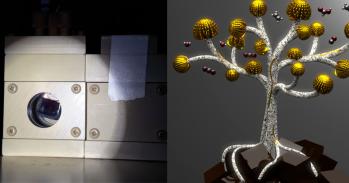The first batch of a new range of powerful superconductors which could revolutionise the production of machines like hospital MRI scanners and protect the national grid has been developed by scientists.
The first batch of a new range of powerful superconductors which could revolutionise the production of machines like hospital MRI scanners and protect the national grid has been developed by scientists.
The processes we have developed and patented should enable us to develop samples that are better, bigger, cheaper and more reliable.
Professor David Cardwell
Engineers at the University of Cambridge used new techniques to manufacture high-temperature superconducting materials, producing samples that can carry record quantities of electrical current for their type and size.
The breakthrough has improved the effectiveness of yttrium barium copper oxide (YBCO) and a related family of superconducting materials. It raises the prospect of more powerful and affordable samples that could have huge benefits in a number of fields.
Researchers discuss these possibilities and demonstrate some of the materials' remarkable magnetic properties in a short film released today (Friday, July 9th) on the University's YouTube channel:https://www.youtube.com/cambridgeuniversity.
Superconductors are materials which, when cooled to a certain temperature, can carry an electrical current without losing energy in the process. This makes them different from standard conductors, such as copper wire, which resist the flow of current with the result that some energy is lost.
In the long term, this means that superconductors could have important environmental benefits by increasing energy efficiency. At the moment, up to 10% of the electrical energy generated by British power stations is lost before it reaches the user because of resistance in the power lines. Superconductors offer no such resistance, could be used to store large quantities of energy until needed and in some cases can carry 100 times more current than copper.
The current also generates a magnetic field, which means that superconductors can be used in numerous other applications. These potentially include MRI scanners in hospitals, "magnetic separators" which cleanse sea-water and lakes, high-speed monorail trains, mechanical flywheels that store energy and, famously, the Large Hadron Collider.
At present, however, effective superconductors are often expensive and difficult to mass-produce. The Cambridge research could be a step towards resolving this, by providing the basis for the development of more powerful samples that can be manufactured using a commercially compatible process.
That would drive down the production costs of machines that rely on the materials. MRI scanners, for example, which can cost around £1.5million each, could eventually become a common sight in GP's surgeries, helping to improve accurate detection and diagnosis of problems ranging from twisted knees to brain tumours.
In addition, superconductors can act as "fault current limiters" within the national grid, protecting it from the energy surge caused by a sudden rise in consumption. These surges, which caused blackouts across the east coast of the US in 2003 and Europe in 2006, can cause lasting damage to both the grid and public infrastructure. Superconducting materials will cease to conduct without significant energy loss if there is a particularly large current, however, meaning that they can be built into the system to shut down the electricity before it reaches the point of use.
"The potential advantages of developing viable high-temperature superconductors are huge," Professor David Cardwell, head of the bulk superconductivity group at the University's Department of Engineering, where the research took place, said. "The processes we have developed and patented should enable us to develop samples that are better, bigger, cheaper and more reliable."
While some materials need to be cooled down to as low as -269 degrees centigrade to superconduct, YBCO does so at the comparatively "high" temperature of -181 degrees C. This means that it can be cooled with liquid nitrogen, rather than liquid helium, which makes it cheaper to operate.
In the past, however, producing effective bulk superconducting devices from the material has proved difficult. YBCO is processed most easily in the form of a polycrystalline ceramic, but has to be manufactured as a single grain in order to generate large magnetic fields since boundaries between grains limit the flow of current in the bulk sample.
In addition, microscopic defects within the material can impede, or 'pin' the motion of magnetic flux lines and increase the flow of current through it. The distribution of these lines within a bulk superconductor has to be managed to maximise the flow of current and therefore the field.
The Cambridge team have developed a technique to manufacture large single grains of bulk superconductors that involves initially heating the material to a temperature of 1,000 degrees C, causing it to part-melt. In a series of experiments, various elements, such as depleted uranium, were then added to the chemical composition of the superconductor to generate artificial flux pinning sites within the single grain.
When the material cooled and reformed, these added materials retained their integrity and formed physical obstacles that form direct the motion of magnetic flux lines, enabling larger currents to flow.
In addition, the team developed a technique for fabricating large, single grains of bulk superconductors in air, using a new type of seed crystal that they have also patented, which enables much more scope for optimising the partial-melt process. Together, these techniques led to the production of samples far more powerful than those fabricated by more standard techniques, which exhibited record energy densities and magnetic fields for their size.
"The properties these samples exhibit could in time offer huge commercial potential by improving or reducing the weight and size of applications such as energy storage flywheels, magnetic separators, motors and generators," Professor Cardwell added. "These devices already use superconductors to varying degrees. With these new bulk processing techniques, we could greatly improve their power and potential."
This work is licensed under a Creative Commons Licence. If you use this content on your site please link back to this page.





